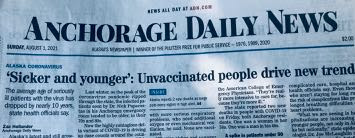My wife had the section of the ADN that I wanted to read on Sunday. So I picked up the Classified Section. It had a long notice:
"NOTICE OF PROPOSED CHANGES TO IMPLEMENT BALLOT MEASURE 2 AND MAKE CLARIFYING CHANGES IN THE REGULATIONS OF THE DIVISION OF ELECTIONS"
This link gives you that notice posted on the State's public notice site.
Given that lots of State Legislatures are busy passing laws intended to disenfranchise voters, this seemed like something I should look at a bit more carefully. This is definitely one of those places where "the devil is in the details" applies.
I've taken some time in the last couple of days to mesh the proposed changes into the body of the current regulations. I've put the proposed changes in red so it's easy to find them. The whole thing is at the bottom of this post.
Things To Know About The Proposed Changes
- The announcement lists all the changes to be made. To be clear, it tells us what needs to be done, but it doesn't tell us the new language, so we don't know what they intend to actually say.
- Most of the changes seem to be apolitical technical changes because of
- passage of Proposition 2 which (1) changed the primary to be a single election with all candidates for each position running against all the others, and (2) changing the general election to ranked choice voting
- State is no longer using Accu-vote machines, so all references to those machines are to be deleted
- US Supreme Court Decision Shelby Co v. Holder to no longer require preclearance of changes in election laws for Alaska and 15 other states.
- Some changes appear to be substantive and while they are simply spelling out the steps to determine the practical implementation of Prop 2, in some cases the wording could potentially directly or indirectly impact the elections, such as:
- Add 6 AAC 25.071 to specify when and how votes for write-in candidates will be counted.
- Add 6 AAC 25.072 to define duplicate rankings and determine how they will be counted.
- Change 6 AAC 25.225 to determine the process for filling a vacancy in the candidacy for lieutenant governor.
- Change 6 AAC 25.240 to remove the specific number of petition booklets that the division will issue. [Current number is "500 or less." Minimally they should change 'less' to 'fewer.']
- Change 6 AAC 25.683 to update a statutory reference; allow someone with a power of attorney to cancel a voter’s registration; remove a reference to selecting a primary ballot; and allow a special power of attorney to include the power to cancel a voter’s registration. [Currently someone with power of attorney can register folks and help with absentee voting. I understand the need to remove deceased voters from the rolls, but my sense is that this could also be used badly. Think Brittany Spears. I haven't heard the arguments, but at this point I think Vital Statistics should share deaths with the Registrar. Given this political climate, I can see people with this power disenfranchising people they disagree with politically. I don't know, just raising questions here.]
- Many changes I'm still trying to figure out what they mean such as
- Add 6 AAC 25.069 to determine that the general election ballot will include space for one write-in candidate per race, except that the races for president and vice-president will not allow write-in candidates.
- Some I have a giant "WHY?" for. There are probably good reasons but it seems odd. For example:
- Add 6 AAC 25.195 to specify that ranked-choice tabulation will begin the 15th day after the election, with only first-choice results reported before then. [I'm guessing this has to do with the need to know the last place candidates in each race, because then the second place vote for the last candidate is given to the next ranked candidate. They may be assuming that you need all the absentee votes in before going to this process. And that may be true in some or even most cases as they need to know the losing candidate before reassigning the 2nd place votes. But I suspect in some cases you'd know before every last ballot is in.]
Some Notes On My Method For Doing This
- Most changes apply to a single section only, but some apply to several (such as every time they mention Accu-vote they need to delete it.) I repeat the red changes for all the sections they apply to.
- When there are multiple changes to a single section, I give each a bullet so you know there are more than one.
- Some are changes to a section ("Remove" or "Change") and some are actually newly numbered sections ("Add") I put the ADD where it would go.
- I've put the proposed changes in red so it's easy to find them.
The Proposed Changes Embedded in the Current Regulations:
Remove repealed statutory authority in 6 AAC 27.035 and 6 AAC 27.150.
Alaska Election Code Propos... by Steve













